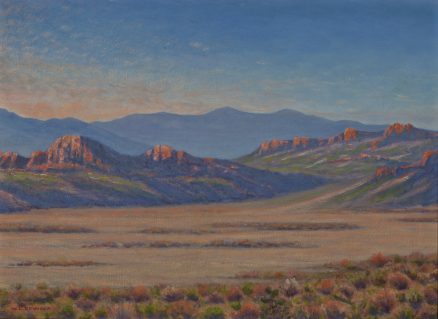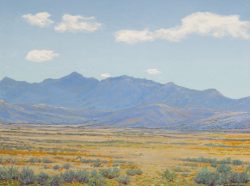- Categories
- Landscapes
- Zoom in on Artwork
- Print Page
- Email Page to Friend
Like DeWolf’s The Desert, this work pictures an open desert vista bordered in the distance by mountains, with scrubby vegetation in the foreground lending a sense of scale. Rather than full daylight, here the light of sunrise or sunset casts deep shadows and transforms the colors of the land. The foreground is muted by shadow as the glancing rays tint rocky outcroppings with brilliant reds and pinks; the distant range is flattened into a featureless jagged band of rich purple-blue. More subtly textured is the sky, which shades from delicate pinks to deep blue near the picture’s top edge. Absent any signs of animate life, the image evokes a timeless serenity even at the most fleeting moment of the desert’s daily cycle.
This painting is probably one of the many images that DeWolf made of the Mojave Desert in California. The artist was celebrated for his interpretations of desert landscapes made in both painting and etching mediums. Few of the titles of his exhibited desert canvases indicate time of day, but included in DeWolf’s 1919 solo show at the Art Institute of Chicago were Evening, Mojave Desert and The Mystic Hour, either one possibly this work. DeWolf might have been describing it in a passage he quoted in his introduction to the catalogue for his earlier Art Institute exhibition: “You shall never see elsewhere as here [the Mojave] the dome, the pinnacle, the minaret fretted with golden fire at sunrise and sunset. . . [or] the sunset valleys swimming in a pink and lilac haze, the great mesas and plateaus fading into blue distance, the gorges and canyons banked full of purple shadows.”i
As a subject in itself, rather than as a backdrop to human or animal activity, the American desert was rarely painted until after the turn of the twentieth century. The expansion of the railroads and the growth of Western tourism were among the factors that encouraged artists to engage this new source of subjects. The desert’s vast, open vistas, its dramatic light and unexpected color, and the often eccentric forms of its terrain inspired painters in search of distinctly American scenery. This was particularly true around the time of World War I, an era of intense nationalism that saw the rise of important communities of artists in desert regions in New Mexico, for example, as well as in Southern California.
Wendy Greenhouse, PhD
Donated by M. Christine Schwartz to the Illinois State Museum, Springfield, Illinois, in 2021
i John C. Van Dyke, The Desert, quoted in DeWolf’s introduction to Exhibition of Paintings by Wallace DeWolf at The Art Institute of Chicago January 4 to January 28, 1917 (Chicago: Art Institute of Chicago, 1917), unpaged.

